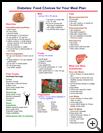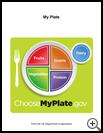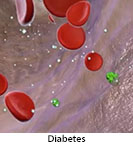
Diabetes: Your Child’s Diet
________________________________________________________________________
KEY POINTS
- There are several ways to plan meals to help manage diabetes. Your diabetes care provider will help you find a meal plan that works for your child.
- Most plans are based on counting carbohydrates (carbs) in food because carbs have the biggest effect on your child’s blood glucose level. Carbohydrates, also called carbs, are a source of energy for the body. Carbs are found in foods such as fruit, soft drinks, candy, pasta, bread, cereals, rice, potatoes, beans, and peas.
- It is important to meet with a dietitian to develop a meal plan that fits your child’s taste and lifestyle, and your family’s budget.
________________________________________________________________________
Why is it important to manage my child’s diet when he has diabetes?
Having diabetes means that there is too much sugar (glucose) in your blood. The body breaks down some of the foods your child eats into sugar. Your child’s blood carries the sugar to the cells of the body. Your child needs the sugar in the cells for energy, but too much sugar in the blood is not good for your child’s health. The body uses insulin to help move sugar from the blood into the cells.
Diabetes is a problem with the way the body makes or uses insulin. Insulin is made by the pancreas, which is an organ in the upper belly. Type 1 diabetes happens when your child’s pancreas stops making insulin. Type 2 diabetes happens when your child’s pancreas doesn’t make enough insulin or the body becomes unable to use the insulin. When your child’s body does not have enough insulin or has trouble using insulin, sugar builds up in the blood and cannot get into the cells.
Type 1 diabetes is treated with insulin, but food choices and exercise are still very important parts of managing blood glucose and preventing complications. The goal of food choices is to try to keep your child’s blood glucose at a normal level throughout the day. This is done by matching your child’s insulin doses with the types and amounts of food he eats. Meal plans can be designed to fit your child’s lifestyle.
With type 2, sometimes your child can control his blood glucose with just diet and exercise. Or he may also need to take oral medicine or insulin shots.
In all cases, understanding how the food your child eats affects blood glucose is an important part of taking good care of your child.
What are the types of meal plans?
There are several ways to plan meals to help manage diabetes. Your diabetes care provider will help you find a meal plan that works for your child. Most plans are based on counting carbohydrates (carbs) in food because carbs have the biggest effect on your child’s blood glucose level. Carbohydrates are a source of energy for the body. There are three basic types of carbs: starches, sugars, and dietary fiber.
- Sugars such as glucose and fructose raise blood glucose very quickly. Sugar is found in foods such as fruit, fruit juices, milk, soft drinks, baked goods, and candy.
- Starches are found in plant-based foods such as pasta, bread, cereals, rice, potatoes, beans, and corn. Some starches are converted to energy very quickly, but others, such as whole grains, are converted more slowly.
- Dietary fiber is the part of plants that cannot be digested. Fiber is found in whole-grain bread and pasta, beans, peas, leafy vegetables, raisins, prunes, apples, and berries. Fiber can help control blood glucose by slowing how quickly your child’s body absorbs sugar from foods.
The most common types of meal plans are:
- The Plate method: This is an easy way to make healthy food choices and control portions, carbs, and calories. Fill half of a 9-inch plate with nonstarchy vegetables. One fourth of the plate should have starches such as whole grains and starchy vegetables. The last quarter of the plate is for proteins such as lean meat. You can have a portion of low-fat milk or yogurt and fruit on the side. You can also add small amounts of healthy fat. This way of planning your child’s meals is focused on getting more vegetables and less starchy foods. This helps to control blood glucose.
- Carbohydrate counting meal plan. This plan helps you figure out the amount of carbs in the foods your child eats at each meal or snack and match your child’s insulin dosage to that carb amount. This plan works best if your child takes insulin with each meal.
- Constant carbohydrate meal plan. With the constant carbohydrate meal plan, your child counts carb choices and eats the same number of carb choices at each meal or snack. Your child takes insulin or other diabetes medicines at the same times and in the same amounts each day.
- Exchange meal plan. This plan divides foods into starch, fruit, milk, fat, vegetable, and meat groups. The plan gives you serving sizes for foods in each group that have about the same amount of carbohydrate, protein, fat, and calories. This lets you exchange, or swap, choices from a food list.
It is important to meet with a dietitian to develop a meal plan that fits your child’s taste and lifestyle, and your family’s budget.
What is a healthy way for my child to eat?
- Eat a well-balanced diet. Help your child eat a balance of fresh vegetables and fruit, low-fat dairy, lean meats and fish, beans, whole grains, nuts and seeds, and use healthy fats such as canola and olive oil.
- Manage carbohydrates carefully. Carbs affect your child’s blood glucose level more than protein or fat. Your child needs to balance how much insulin he takes with the amount of carbs he eats. This helps keep your child’s blood glucose at a healthy level and helps prevent many health problems. Testing your child’s blood glucose 2 hours after a meal will help you find out how eating different combinations of foods can affect your child’s blood glucose. Learning how your child’s body responds to foods will help improve his blood glucose control.
- Eat meals at the same time each day. Insulin and oral diabetes medicines will lower your child’s blood glucose whether he eats or not. It’s important not to miss meals. Your child should try to eat at about the same time each day to prevent low blood glucose. Make sure that he carries snacks in case of a change in schedule that affects your child’s mealtime.
- Use snacks to prevent insulin reactions. Snacks help to keep your child’s blood glucose from going too low after taking insulin. Although there are some general times that you can expect each type of insulin to reach its peak activity, actual peaks vary from person to person. Your child will learn from experience when he needs a snack. Different types of snacks have different effects. Sugar from fruit will last 1 or 2 hours, so fruit is good for a morning or afternoon snack. Carbs such as whole grain crackers or bread eaten with proteins such as low-fat cheese or meat, change to sugar more slowly. If your child has low blood glucose during the night, add a lean protein to his evening carbohydrate snack. This can help the sugar last through the night. Milk and yogurt are a natural mix of carbohydrate and protein and make a good bedtime snack choice.
- Limit cholesterol, saturated fat, and trans fat in your child’s diet. Eating too many foods high in cholesterol, saturated fat, or trans fat can lead to high levels of the fatty materials in the blood called cholesterol and triglycerides. High cholesterol increases the risk for heart disease. People who have diabetes have a higher risk of getting heart disease, so it is important to watch the cholesterol and fat in your child’s diet. Check food labels and choose those with lower amounts of cholesterol, saturated fat, and trans fat.
Blood cholesterol and triglyceride levels can be high if blood glucose levels are too high. Your child’s blood cholesterol level and triglyceride level should be checked at least once a year. Your dietitian can help you adjust your child’s diet if you need to.
- Keep a healthy weight. Ask your dietitian how many calories your child needs to eat every day. If your child is overweight, talk to your dietitian about making a plan for gradual weight loss. Losing weight will also make it easier to control your child’s blood glucose.
- Eat more fiber. Fiber is the part of plants that cannot be digested. Adding fiber may help lower blood glucose levels. For example, your child’s blood glucose may not be as high after eating beans than it is after eating white bread because beans have more fiber. Raw fruits, vegetables, beans, nuts, oatmeal, popcorn, and whole-grain breads are good high-fiber foods.
- Avoid foods high in salt (sodium). Eating a lot of salt may raise your child’s blood pressure. High blood pressure increases the risk for stroke, and complications of diabetes such as heart, eye, and kidney problems. Talk to your dietitian about how much salt your child should have each day.
- Avoid too much protein if your child has kidney problems. Eating too much protein can be a problem if your child has kidney disease. Follow your healthcare provider's recommendation for how much protein your child should eat. A dietitian can help you plan a lower protein diet.
For more information, contact
- The American Diabetes Association
800-342-2383
http://www.diabetes.org
Last modified: 2018-01-10
Last reviewed: 2018-01-10



